
Introduction to Dieffenbachia
Overview of Dieffenbachia and Its Appeal as a Houseplant
Dieffenbachia, with its lush green foliage and tropical charm, has earned a prime spot in the world of indoor plants. Known for its distinctive, large leaves adorned with captivating variegations, this plant effortlessly elevates any interior space. While several varieties exist, the Dieffenbachia picta stands out as one of the most popular due to its striking patterns and manageable care needs.
Dieffenbachia’s aesthetic appeal lies in its foliage, which often features an intriguing blend of green, white, or creamy tones that brighten any room. Its ability to thrive in low to medium light makes it a favorite choice for areas where sunlight might be limited. Additionally, the Dieffenbachia care upright, bushy growth pattern makes it an ideal statement plant, offering height and volume that easily fits into various home décor styles. But its allure doesn’t stop at looks; Dieffenbachia is also known for its resilience, allowing even beginners to enjoy its beauty with minimal maintenance.
Key Benefits of Growing Dieffenbachia Indoors
There are several advantages to adding a Dieffenbachia to your indoor plant collection beyond just its appearance. First and foremost, Dieffenbachia is known for its air-purifying abilities. It can remove common indoor pollutants, contributing to improved air quality, which in turn supports a healthier living environment. This natural air-filtering quality makes it especially valuable in urban settings or homes where fresh air might be limited.
Another benefit of Dieffenbachia care is its relatively low-maintenance nature. While it appreciates attention to watering and proper lighting, this plant is forgiving if you happen to miss a watering day here and there. Its durability makes it ideal for busy plant lovers or for those who are just starting on their indoor gardening journey.
Lastly, Dieffenbachia brings a touch of the tropics indoors, creating a calming and green atmosphere. Studies have shown that indoor plants can reduce stress and improve mood, and Dieffenbachia care is no exception. Its presence in any room offers a serene, natural ambiance that invites relaxation. Whether placed in a living room corner or near an office desk, Dieffenbachia picta can enhance the atmosphere, promoting a sense of well-being.
In summary, Dieffenbachia is not only a strikingly beautiful plant but also offers several practical benefits for indoor growers. Its easy care requirements, coupled with its air-purifying capabilities and soothing aesthetic, make it a top choice for plant enthusiasts seeking to enrich their living spaces.
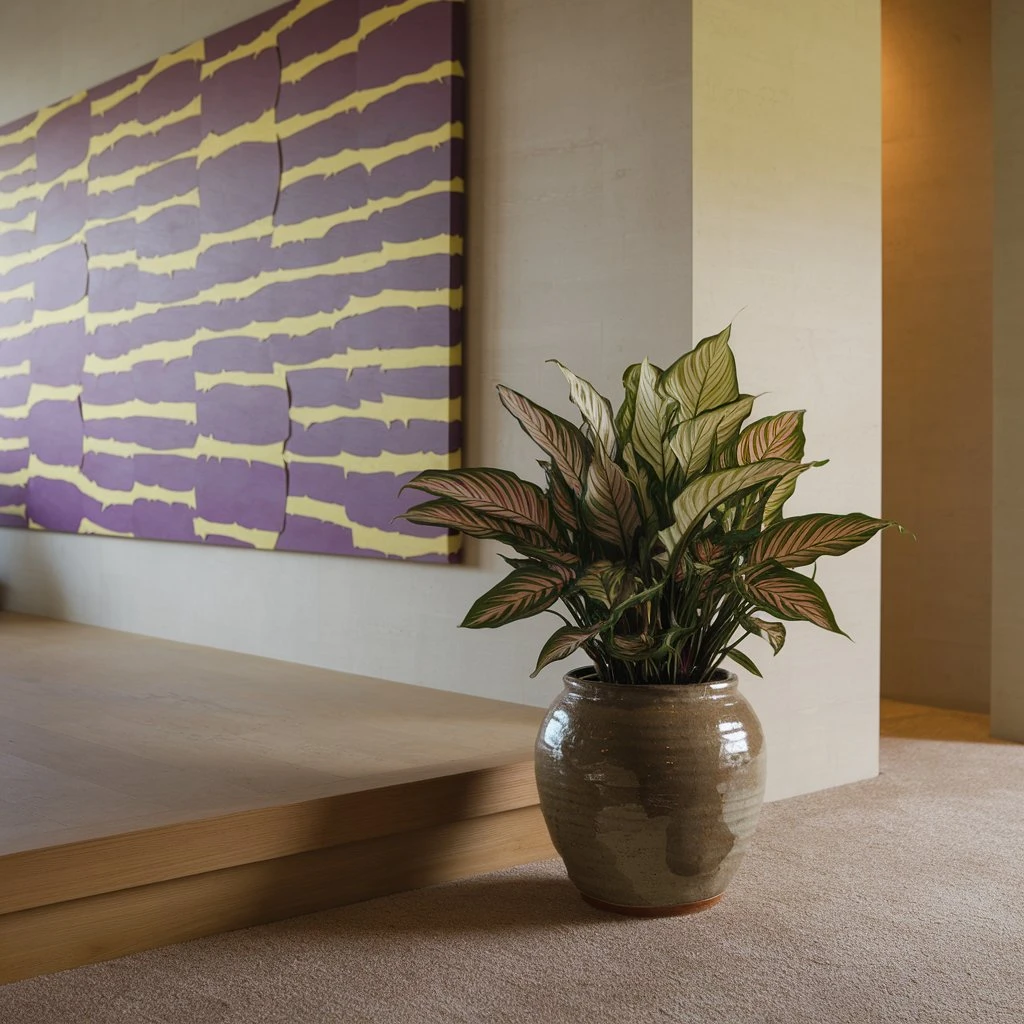
Ideal Locations for Planting Dieffenbachia
Best Indoor Spots: Light and Space Considerations
When it comes to choosing an ideal indoor location for Dieffenbachia, lighting is key. This tropical plant flourishes in bright, indirect light, which simulates the dappled sunlight it would naturally receive under a canopy in the wild. An east-facing window is often perfect, providing gentle morning light without the risk of intense rays that can scorch the leaves. Alternatively, north-facing windows offer soft light throughout the day, which also works well for Dieffenbachia. Avoid placing it in direct sunlight, as this can fade its attractive variation and damage the foliage.
Space is another important factor. Dieffenbachia picta can reach impressive heights, so be sure to select a spot that allows for its potential growth. This means avoiding cramped corners or tight spaces where leaves might brush up against walls or furniture. Instead, place it where it has a bit of room to grow freely; a few feet away from the window provides sufficient light while giving the plant space to thrive.
Choosing the Right Area in Your Home for Optimal Growth
In terms of room placement, Dieffenbachia performs well in living rooms, offices, or bedrooms, where it can enjoy consistent light and stable temperatures. A temperature range between 65°F and 75°F is ideal, keeping Dieffenbachia care comfortable without exposure to drafts or abrupt temperature changes. If possible, place it away from vents or frequently opened doors that could cause temperature fluctuations.
Bathrooms can also be a favorable environment, as Dieffenbachia picta appreciates humidity. If natural light is available, the higher moisture level in a bathroom can be advantageous for its lush growth. Choose a spot where the plant can receive moderate light, and you’ll have a thriving Dieffenbachia care that brings a touch of nature indoors, beautifying any chosen area.
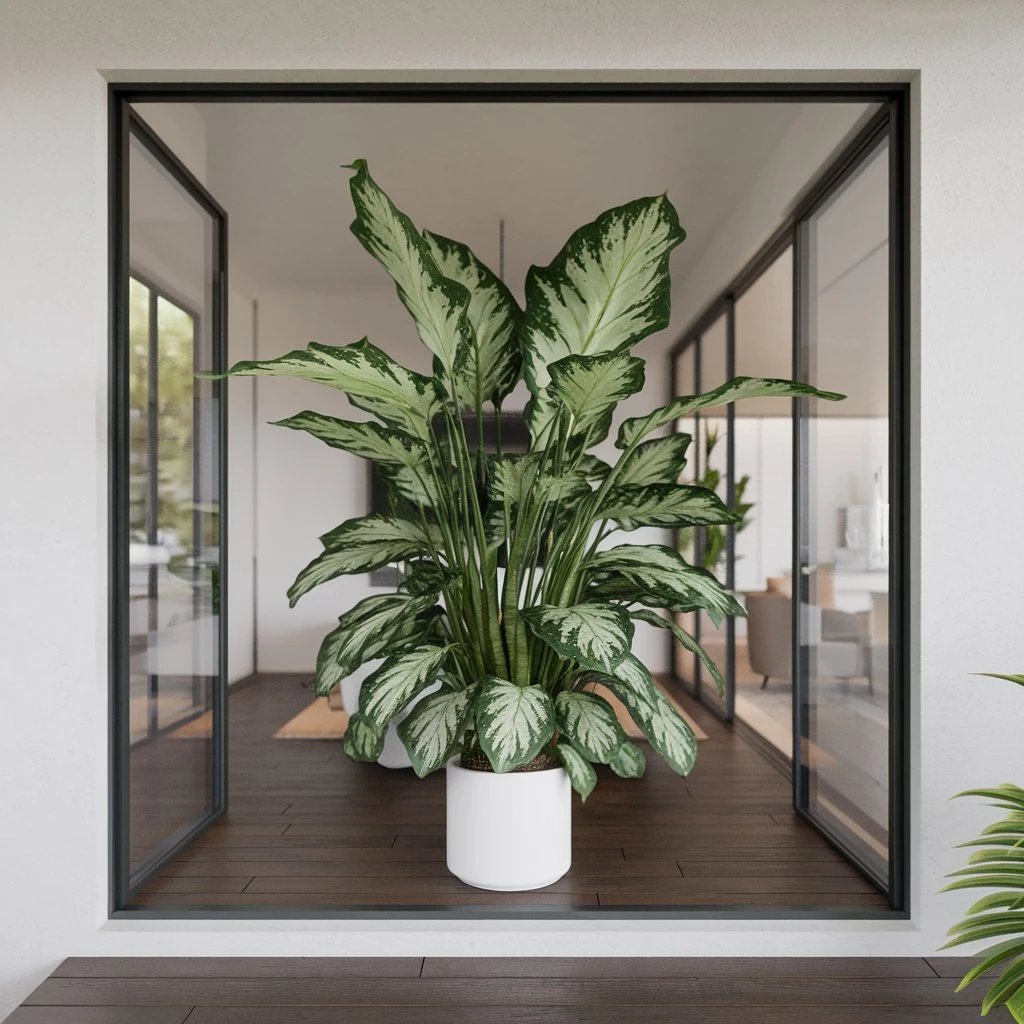
Planting Dieffenbachia: Essential Steps and Timing
Preparing Dieffenbachia for Planting: Potting Mix and Container Choice
Getting Dieffenbachia off to a strong start begins with choosing the right potting mix and container. This tropical beauty thrives in a well-draining soil that retains some moisture but doesn’t become overly saturated. A high-quality potting mix with added perlite or peat moss offers the ideal texture for Dieffenbachia indoor care, ensuring that excess water doesn’t linger around its roots, which could lead to root rot. Avoid heavy garden soils, as they may compact and suffocate the plant’s roots over time.
Choosing the right container is equally crucial. Select a pot with drainage holes to help maintain the right moisture levels in the soil. When it comes to size, a pot that is slightly larger than the root ball is perfect. Too large of a container can hold excess water, while too small of a pot may restrict the plant’s growth. An ideal container gives Dieffenbachia room to grow but isn’t so spacious that moisture levels are hard to control.
When and How to Plant Dieffenbachia for Strong Root Establishment
The best time to plant or repot Dieffenbachia care is during the warmer months, typically in spring or early summer. This timing aligns with the plant’s active growing period, allowing roots to establish quickly in their new environment. Avoid planting or repotting in winter, as growth slows and the plant may struggle to adapt.
To plant, fill the bottom of the container with a layer of potting mix, gently place the Dieffenbachia care in the pot, and then fill around it with soil. Pat the soil lightly around the base to support the plant without compacting it. Ensure the soil is well-watered, permitting it to compact around the roots effectively. This method promotes strong root establishment, setting the stage for robust growth throughout the season.
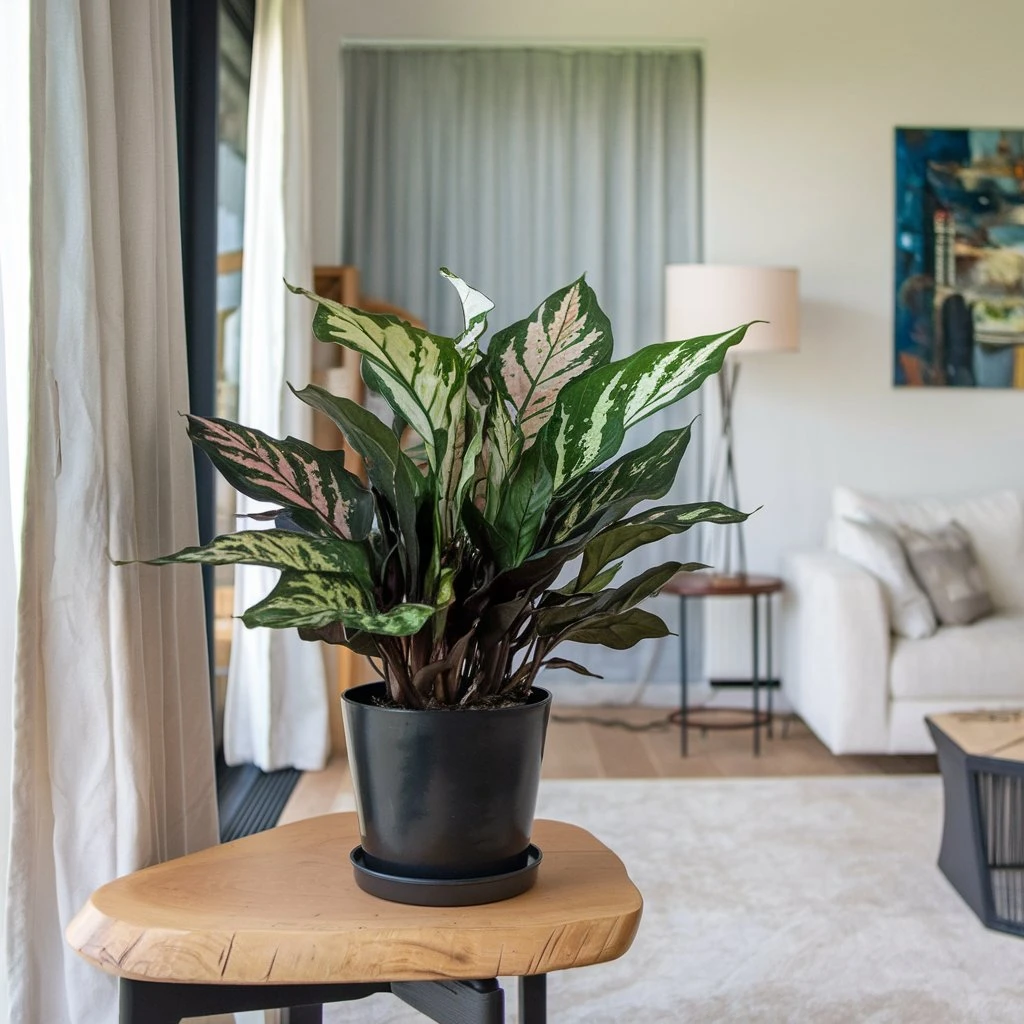
Comprehensive Dieffenbachia Care Guide
Light Requirements: Ideal Lighting Conditions and Common Issues
Dieffenbachia, also known as dumb cane, enjoys bright, indirect light, which mimics the dappled sunlight it would receive in a tropical forest. Although Dieffenbachia care is fairly adaptable to various indoor light levels, providing too much direct sunlight can scorch its delicate leaves, causing them to yellow or develop brown spots. A north- or east-facing window is ideal, offering gentle, indirect rays that prevent sunburn while keeping the foliage lush. If you notice the plant leaning towards a light source, rotate it occasionally to encourage even growth.
In lower-light environments, Dieffenbachia will survive but may exhibit slower growth or longer stems. If the leaves begin to lose their vibrant variegation, it could be a sign that the plant needs more light. Supplemental lighting with a grow light can help maintain brightness without overwhelming the plant.
Soil and Watering Needs: Maintaining Moisture Levels Without Overwatering
The right soil and watering routine are critical for healthy Dieffenbachia growth. This plant prefers well-draining soil with a light, airy structure that holds moisture without becoming waterlogged. A potting mix that includes peat moss, perlite, or sand is an excellent choice for Dieffenbachia care, as it provides a balance of moisture retention and aeration, helping to prevent root rot.
It is advisable to let the top inch of soil dry out before watering again. This plant is sensitive to overwatering, which can lead to yellowing leaves and root rot. In summer, your Dieffenbachia care may need water every week, while in cooler months, a longer interval may be needed. It is essential to make sure that the pot includes drainage holes to facilitate the escape of excess water. Remember, it’s better to underwater slightly than to overdo it, as the latter can quickly damage the plant.
Temperature and Humidity: Creating a Tropical Environment Indoors
Native to tropical climates, Dieffenbachia care thrives in warm, humid environments. Ideally, maintain indoor temperatures between 65°F and 75°F (18°C to 24°C) for optimal growth. Sudden drops below 50°F (10°C) can shock the plant, causing leaves to wilt or even die. Keeping your Dieffenbachia picta away from cold drafts, air conditioning vents, and direct heat sources will help maintain a stable, comfortable temperature.
Humidity is another crucial factor for Green Dragon indoor care health, as this plant prefers a humidity level of around 60%. If your indoor environment is dry, especially in winter, consider increasing humidity by using a humidifier, misting the leaves, or placing the pot on a pebble tray with water. Browning edges on the leaves are often a sign of low humidity, so watch for this indicator if you suspect the air is too dry.
Fertilizing: When and How to Feed Dieffenbachia for Optimal Growth
For vibrant foliage and steady growth, Green Dragon benefits from regular feeding. Use a balanced, water-soluble fertilizer diluted to half strength once a month during the growing season, typically from spring to early fall. Fertilizing provides essential nutrients that keep the foliage lush and colorful, especially for variegated varieties like Dieffenbachia care.
In winter, reduce or halt fertilization as the plant’s growth slows down and it requires less nourishment. Excessive fertilization can result in the accumulation of salts in the soil, potentially leading to leaf burn. To prevent this, flush the soil with water every few months to remove excess minerals.
Pruning for Health and Shape: Tips for Managing Size and Encouraging New Growth
Pruning Dieffenbachia serves both an aesthetic and a functional purpose. By removing yellowing, damaged, or leggy growth, you can maintain the plant’s shape and encourage healthier, fuller foliage. Use sterilized pruning shears to trim back overgrown stems, focusing on cuts just above a node where new leaves will emerge. For safety, remember that Dieffenbachia indoor care sap can be irritating to skin, so consider wearing gloves while pruning.
Pruning also provides an opportunity to control the size of your Green Dragon, keeping it at an ideal height for indoor spaces. Regular trimming promotes bushier growth, preventing the plant from becoming too tall and sparse. Removing any leaves that have lost their luster or are blocking light for lower foliage helps keep the entire plant looking its best.
Potting and Repotting: Recognizing When to Repot and Best Practices
As Green Dragon grows, it will eventually outgrow its container and require repotting to ensure healthy root development. Signs that your plant is ready for a new pot include roots growing out of the drainage holes, soil that dries out too quickly, or slowed growth. Repotting is best done in early spring, before the growing season begins in earnest.
To repot, choose a pot that is one size larger than the current container. Gently remove the plant from its pot, carefully shaking off old soil from the roots, and inspect for any signs of root rot or decay. Fill the new container with fresh potting mix, place the Dieffenbachia picta in the center, and fill in around the roots with soil, pressing lightly to secure it in place. After repotting, water thoroughly and allow the plant time to adjust to its new environment. With proper potting care, your Dieffenbachia will continue to flourish, adding a lush tropical feel to your indoor space.

Common Pests and Problems in Dieffenbachia
Identifying and Treating Common Pests: Prevention and Care
Dieffenbachia can occasionally attract pests like spider mites, aphids, and mealybugs, which feed on its sap, weakening the plant. Look for small, webbed clusters, sticky residues, or tiny moving specks on the leaves. To treat infestations, wipe the leaves gently with a mixture of water and insecticidal soap, and isolate the plant if pests persist. Regularly misting or showering Dieffenbachia picta helps to deter these pests, as they thrive in dry, still air. Checking your plant weekly can prevent minor issues from escalating.
Addressing Common Dieffenbachia Issues: Leaf Yellowing, Browning, and Drooping
Leaf yellowing or browning in the Dieffenbachia plant often results from improper watering, typically due to overwatering or underwatering. Ensure the soil drains well and water only when the top inch of soil feels dry. If leaves droop, inspect the roots and check for signs of root rot, which can occur in persistently soggy conditions. Low humidity can also cause browning leaf tips on Dieffenbachia care. Increasing humidity or placing a pebble tray with water beneath the plant can alleviate dryness. By addressing these issues proactively, you can help your Green Dragon remain vibrant and healthy.

Propagation Techniques for Dieffenbachia
Division Propagation: Step-by-Step Process for Propagating Through Root Division
For Dieffenbachia enthusiasts, root division is one of the most effective methods to expand your collection. This technique involves carefully dividing the plant’s root system, making it ideal for mature plants with multiple stems. Start by removing the plant from its pot and gently shaking off excess soil to expose the roots. Using a sterilized knife, separate the roots into sections, ensuring each section has a healthy root ball and at least one stem. Plant each division in its own container with fresh, well-draining soil. Water thoroughly and place in a warm, indirect light location to encourage new growth. This method allows for a healthy, robust new plant with minimal risk.
Stump Propagation: How to Regrow Dieffenbachia from a Stump
Dieffenbachia picta can be surprisingly resilient, even when reduced to a bare stump. This method is particularly useful for leggy or overgrown plants. Cut the top portion of the plant, leaving a few inches of stump with at least one growth node. Place the stump in a container with fresh soil, and water lightly. Within weeks, new shoots typically emerge from the base, rejuvenating the plant. Stump propagation offers a practical way to recycle an older plant, breathing fresh life into an existing Dieffenbachia plant without starting from scratch.
Stem Cuttings: Best Practices for Successful Cuttings
Stem cuttings are a popular way to propagate Green Dragon, especially if you want to create multiple plants from a single stem. Choose a healthy stem and cut a section with at least two nodes. For best results, allow the cutting to air dry for a few hours to prevent rot, then dip the cut end in rooting hormone. Place the cutting in a small container with moist potting mix, and cover it with a plastic bag to create a mini greenhouse effect. Place in indirect light and keep the soil moist but not soggy. Within a few weeks, roots should start forming, and you can remove the plastic cover once new growth is visible.
Air Layering: Advanced Propagation Technique for Dieffenbachia
Air layering is an advanced technique often used for larger Dieffenbachia picta plants. This method involves encouraging roots to grow on a stem before cutting it from the parent plant. Select a healthy stem and make a shallow cut around the circumference. Wrap the wounded area with damp sphagnum moss, securing it with plastic wrap to maintain moisture. Keep the moss moist until roots develop within the wrapping, which may take a few weeks. Once a good root system is established, cut below the rooted area and plant it in fresh soil. Air layering is an ideal technique for those wanting to propagate a mature Green Dragon without disrupting the parent plant.
These methods of propagation allow Dieffenbachia plant owners to cultivate new plants effectively, ensuring a lush, thriving collection of this vibrant indoor plant.
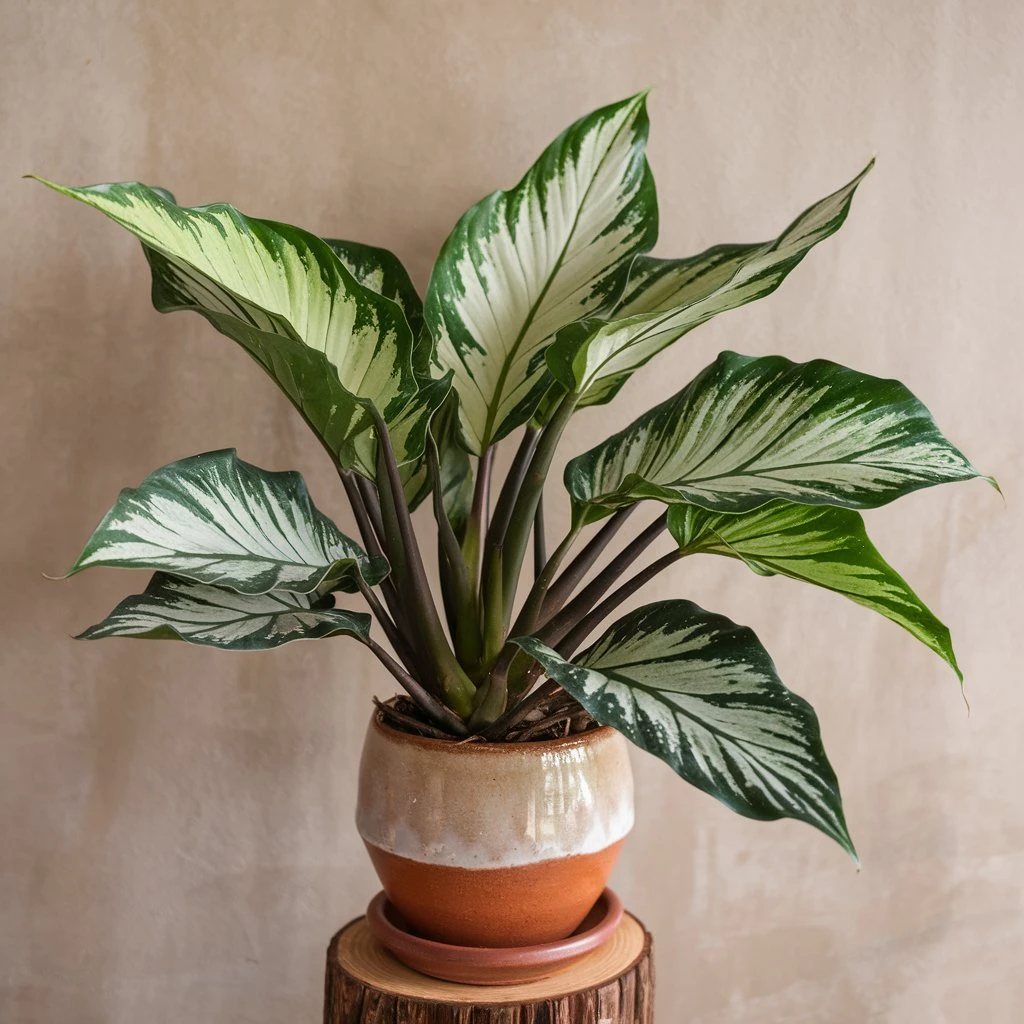
Popular Dieffenbachia Varieties
Overview of Key Dieffenbachia Types and Their Unique Features
Dieffenbachia is a favorite among indoor plant lovers, thanks to its striking foliage and relatively easy care requirements. With varieties ranging in color, size, and leaf pattern, this genus offers something for every taste. Whether you’re drawn to classic green-and-white leaves, dramatic variegation, or intricate patterns, there’s a Green Dragon to suit every home decor. Each type has its own characteristics, from light needs to ideal humidity levels, and knowing these can help you choose the right variety to thrive in your home.
‘Camilla’ Dieffenbachia: Characteristics and Ideal Growing Conditions
The ‘Camilla’ Dieffenbachia is known for its delicate, creamy-white leaves edged in deep green, creating a subtle contrast that adds an elegant touch to any room. This variety is relatively compact, making it perfect for smaller spaces. ‘Camilla’ thrives in bright, indirect light but tolerates lower light conditions, making it adaptable to various spots in your home. Keep the soil consistently moist but avoid overwatering, as its roots are sensitive to excess water. A moderately humid environment will keep ‘Camilla’ healthy, and occasional misting can enhance its vibrancy.
‘Camouflage’ Dieffenbachia: Distinctive Patterns and Maintenance Tips
The ‘Camouflage’ Dieffenbachia boasts unique, almost military-like patterns on its leaves, featuring multiple shades of green that create an intriguing look. This variety adds a lush, exotic vibe to any indoor space. Unlike other types, ‘Camouflage’ benefits from medium to bright indirect light to maintain its vibrant patterns. Ensure the soil is well-watered, but allow it to dry out a bit between watering sessions to avoid the risk of root rot. This variety is less tolerant of low humidity, so placing it near a humidifier or frequently misting it will help it thrive. ‘Camouflage’ Dieffenbachia stands out with its bold look, making it an excellent focal point in any plant collection.
Dieffenbachia Maculata: Features and Growing Needs
Dieffenbachia Maculata, commonly called “Spotted Dieffenbachia,” is known for its distinctive spotted leaves. This variety has large, oblong leaves with yellow or white spots that contrast with its dark green background. It’s a moderately sized plant, so it’s great for filling up an empty corner or accentuating a tabletop display. Dieffenbachia plant Maculata prefers bright, indirect sunlight to keep its striking pattern, but it can handle lower light if necessary. It thrives in well-draining soil and requires regular watering to stay vibrant, although it should be allowed to dry out a bit between waterings. This variety is known for its adaptability, but keep an eye out for yellowing leaves, which can be a sign of overwatering.
‘Tropical Tiki’ Dieffenbachia: Unique Attributes and Care Tips
‘Tropical Tiki’ Green Dragon is a standout variety, known for its bold and large leaves with intricate patterns. The leaves are variegated with shades of green and cream, creating a tropical feel that adds vibrancy to any interior. This variety thrives in medium to bright indirect light, and its leaves will show more intense colors in brighter conditions. Unlike other types, ‘Tropical Tiki’ is a bit more sensitive to cold drafts, so placing it in a stable, warm environment is essential. Water moderately, ensuring that the soil is evenly moist but not soggy. As a tropical plant, the ‘Tropical Tiki’ Dieffenbachia plant appreciates high humidity and benefits from regular misting, making it ideal for bathrooms or kitchens where humidity is naturally higher.
Dieffenbachia Seguine: Identifying Traits and Care Needs
Dieffenbachia Seguine is one of the most popular varieties, appreciated for its large, glossy leaves with striking white or yellowish veins. This variety can grow quite tall, making it an impressive statement plant for any room. Green Dragon Seguine prefers bright, indirect light but is quite forgiving if light levels fluctuate. It thrives in a high-humidity environment, which helps prevent browning leaf edges. Regular watering is crucial, though it’s important not to let the roots sit in water. Fertilizing every two months during the growing season will ensure Dieffenbachia Seguine maintains its lush, vibrant look.
‘Tropic Marianne’ Dieffenbachia: Best Practices for This Variety
The ‘Tropic Marianne’ Dieffenbachia is a lovely variety with large, soft green leaves that display a subtle light-green variegation in the center. Known for its refined look, it’s a favorite choice for those looking to add a touch of calm elegance to their space. ‘Tropic Marianne’ thrives in medium to bright, indirect light, though it can tolerate lower light if needed. Regular watering is essential, and it’s best to keep the soil consistently moist without becoming waterlogged. This variety doesn’t demand high humidity but benefits from occasional misting, particularly in drier environments. ‘Tropic Marianne’ Dieffenbachia indoor care is relatively low-maintenance, making it an excellent choice for beginners.
‘Tropic Snow’ Dieffenbachia: Care Recommendations for Successful Growth
‘Tropic Snow’ Dieffenbachia is another eye-catching variety, featuring wide, lush leaves with a central variegation that alternates between creamy white and soft green. This variety can grow impressively tall, often reaching up to six feet indoors if given optimal conditions. ‘Tropic Snow’ appreciates bright, indirect sunlight but can adapt to lower light if necessary. To prevent leaf burn, avoid direct sunlight. It’s essential to water this variety moderately, allowing the top inch of soil to dry out between waterings to prevent root rot. High humidity and a warm environment are key to ‘Tropic Snow’ Dieffenbachia picta’s health, making it an ideal plant for indoor jungle lovers who want a bold, tropical look in their space.
Each of these Dieffenbachia varieties offers unique beauty and personality, catering to different aesthetic tastes and growing environments. Whether you’re looking for a low-maintenance green companion or a striking plant with intense variegation, Dieffenbachia picta care provides a versatile range of options that can thrive in various indoor settings.
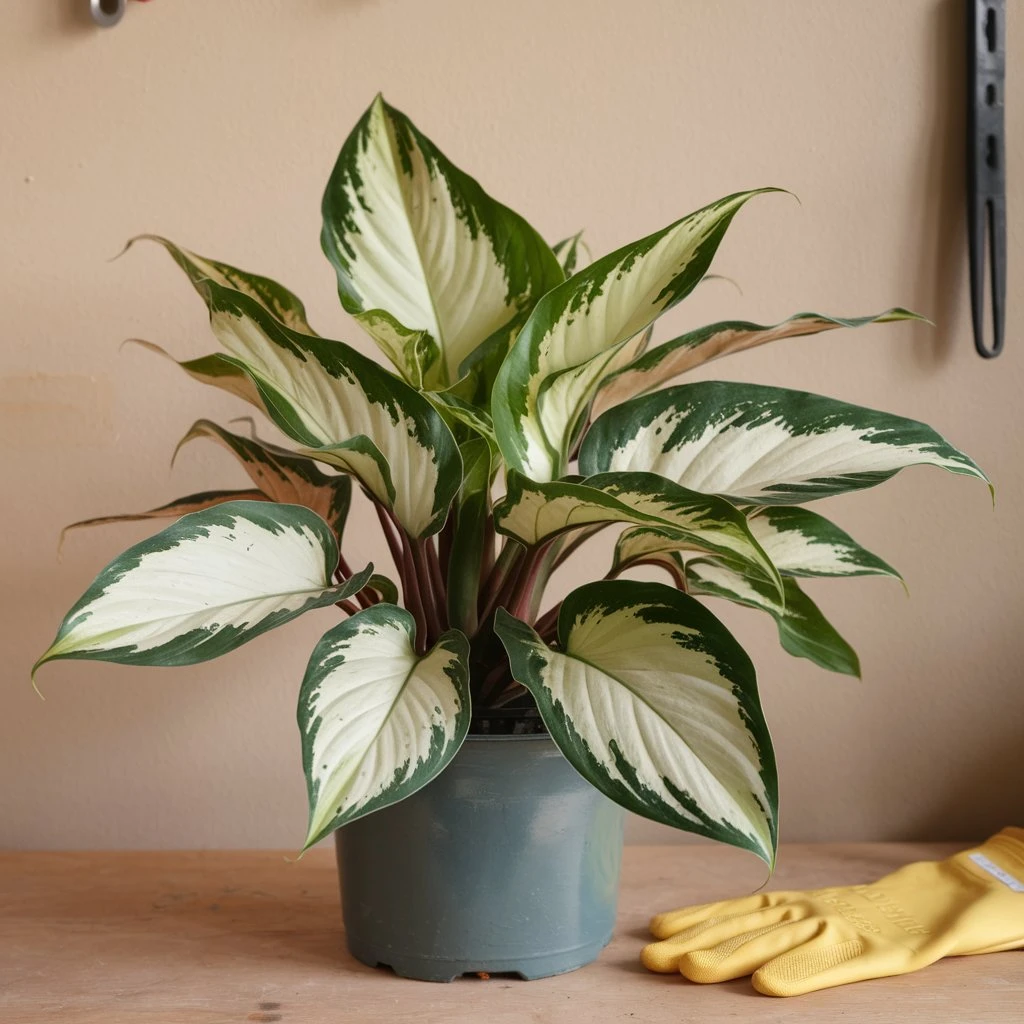
Seasonal and Special Care Considerations
Preparing Dieffenbachia for Winter: Overwintering Tips
As temperatures drop, Dieffenbachia plants require adjustments to help them survive and thrive through winter. Since these tropical beauties are sensitive to cold, keep them in a consistently warm location away from drafts or cold windows. Indoor temperatures around 65-75°F are ideal for their continued health. Reduce watering frequency in winter, as Dieffenbachia indoor care typically enters a slower growth phase and requires less moisture. Overwatering in the winter months can lead to root rot, so allow the top inch of soil to dry out between waterings. Low indoor humidity can also cause leaf edges to brown; using a humidifier or placing a water tray nearby can help maintain the moisture they crave.
Seasonal Maintenance Needs: Adapting Care for Spring, Summer, and Fall
During the growing season—spring and summer—Dieffenbachia becomes more active and benefits from extra care. In these warmer months, increase the watering frequency and ensure the soil remains slightly moist but never waterlogged. A balanced liquid fertilizer applied every four to six weeks will help your Dieffenbachia grow robustly, especially if it’s a variety like Dieffenbachia picta with large, lush leaves.
As fall approaches, gradually reduce fertilization and water less frequently to help the plant transition to its dormant period. Regularly remove any dead or yellowing leaves to maintain overall health and appearance. Seasonal pruning can help manage the size and encourage fuller growth as the seasons change, keeping your Green Dragon vibrant all year long. By tailoring care to each season’s demands, your plant can flourish beautifully from season to season.
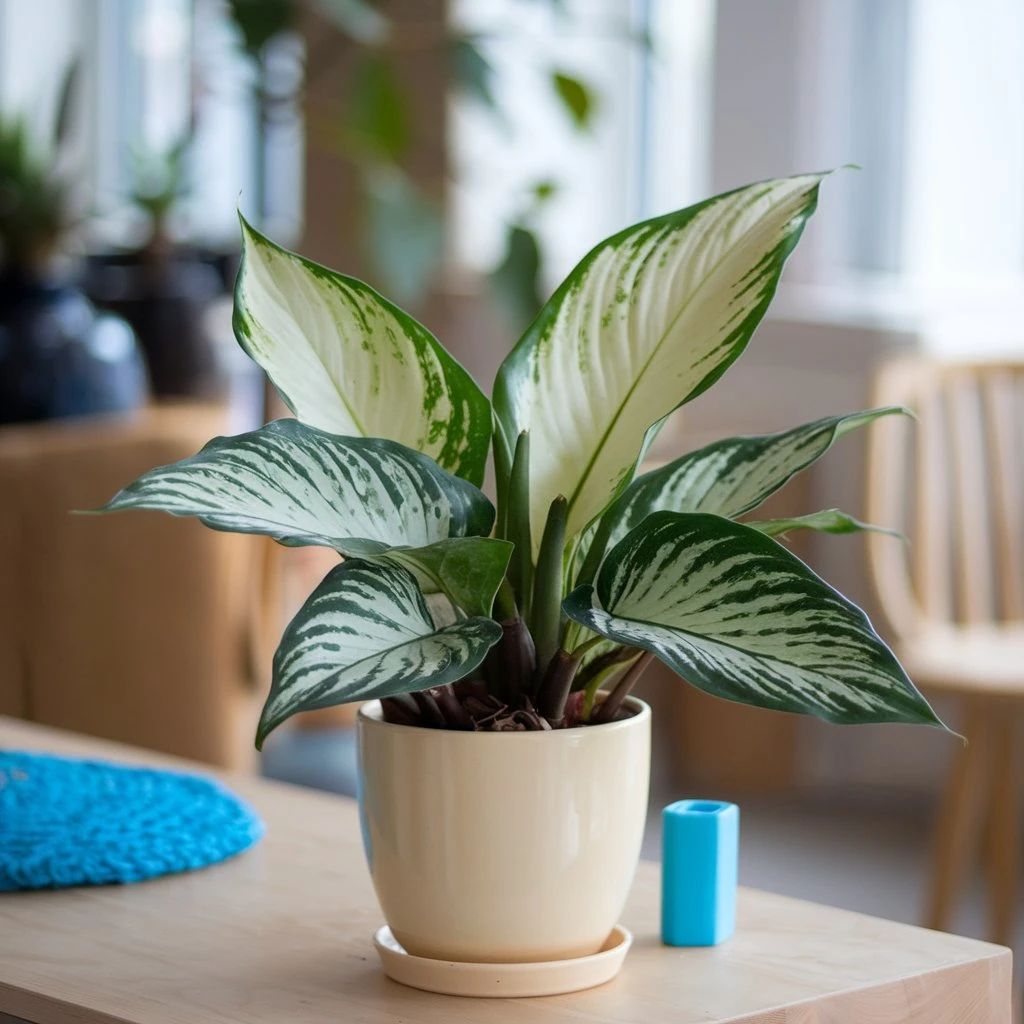
Frequently Asked Questions About Dieffenbachia
Common Queries About Dieffenbachia Care, Growth, and Maintenance
Dieffenbachia is a popular houseplant known for its striking foliage and relatively easy care, but owners often have questions to ensure it thrives. One of the most common inquiries is about light requirements. While Green Dragon adapts to various light conditions, it truly thrives in bright, indirect sunlight, which helps maintain its vibrant colors. Another frequent question revolves around watering needs: to keep Dieffenbachia picta healthy, aim for a balance where the soil is kept consistently moist but not saturated. During its growing season in spring and summer, you can water more frequently, allowing the top inch of soil to dry slightly between waterings.
Addressing Safety and Toxicity Concerns for Homes with Pets or Children
A key concern for many plant enthusiasts is the safety of Dieffenbachia in homes with pets or young children. It’s important to note that Dieffenbachia indoor care, including varieties like Dieffenbachia picta, contains calcium oxalate crystals, which can be toxic if ingested. These crystals may cause irritation in the mouth, throat, or stomach, so placing the plant in a location out of reach of pets and children is recommended. For added caution, consider displaying Green Dragon on a high shelf or in a hanging planter. Educating household members about the plant’s toxicity and observing these precautions ensures that everyone enjoys the beauty of this tropical plant without worry.

Recap of Dieffenbachia’s Beauty and Practicality as a Houseplant
Dieffenbachia stands out as a sophisticated choice for indoor plant enthusiasts, offering both aesthetic charm and low-maintenance care. With its lush, variegated leaves and elegant stature, Dieffenbachia picta Care and other varieties bring a touch of tropical allure to any indoor space. Beyond its decorative appeal, Dieffenbachia picta care is incredibly practical, thriving in diverse light conditions and requiring minimal attention compared to other tropical plants. For those seeking a stylish yet manageable plant, Dieffenbachia picta perfectly balances beauty and convenience.
Final Tips for Growing a Healthy, Thriving Dieffenbachia
To ensure your Dieffenbachia indoor care flourishes, provide bright, indirect light and maintain a moderate watering routine—keeping the soil slightly moist without over-saturation. Regularly misting or using a humidity tray can also help mimic the plant’s natural environment, especially during dry winter months. Fertilize occasionally during the growing season and keep an eye out for any signs of pests or leaf discoloration as indicators of environmental adjustments needed. With these simple practices, your Green Dragon caregiver-chosen variety will grow robustly, providing an enduring display of its tropical elegance and resilience in your home.


